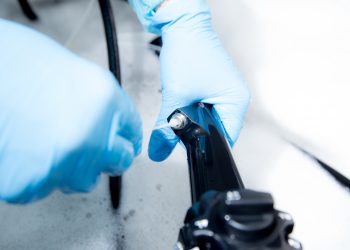Our small intestine is host to a finely tuned microbiota machine, performing countless functions to digest and process stomach contents and move things toward the large intestine. But any imbalance in this tiny ecosystem can throw a cog in the machine—including bacteria.
Paulina Roszkowska and associates wrote in a review in Biomedicines that “SIBO is defined as an increase in the number of bacteria (103–105 CFU/mL), an alteration in the bacterial composition, or both in the small intestine.” Symptoms can include chronic diarrhea, weight loss, malabsorption, nutritional deficiencies and osteoporosis. Or they can be as common as bloating, distension, fatigue and weakness. Severe cases can present with steatorrhea.
Complications include malabsorption and fat-soluble vitamin deficiencies leading to neuropathy. But as with so many disorders, these symptoms can indicate other diseases, too, which is why a substantive diagnosis is so important.
Working For a Living
We already know that our intestinal microbiota play a significant role in the body’s immune function. To riff on a catchphrase, “If the gut ain’t happy, ain’t nobody happy.” Our microbiome works hard to ensure the gut’s “happiness” and efficacy. It not only breaks down food, empowers metabolism and enables the synthesis of certain nutrients, but it also protects the body against potentially pathogenic bacteria.
Put simply, our microbiome is full of a spectrum of amazing multitaskers. And this team never takes a vacation.
But our happy microscopic community can be affected by many factors, including the host’s age, food choices, use of pharmaceuticals, lifestyle and stress, among others. Starting in the mouth, which can host up to 700 species of bacteria, the microbiome alters in size and composition in the stomach, small intestine, large intestine and colon. Stomach acid kills off a lot of interlopers, but it’s in the intestines where things really get interesting, with the number and diversity of microorganisms increasing as the food progresses through digestion. Bacteroides, Lactobacillus and Streptococcus species dominate the jejunum, while in the ileum, microorganisms such as Enterococcus, Veilonella and Enterobacterales join the party. By the time we’ve arrived at the large intestine, we’re sharing space with about 800 species of symbiotic, opportunistic, and pathogenic bugs, predominantly anaerobic.
In SIBO, we see a proliferation of small intestinal bacteria, including those “Gram-negative aerobic and anaerobic species,” according to Roszkowska, et al. “In the physiological state, there are mechanisms to prevent excessive colonization of bacteria in the small intestine, such as acidic stomach pH, pancreatic enzymes, the intestinal immune system, small intestine peristalsis, the ileocecal valve, and the intestinal barrier itself. However, when changes in any of these mechanisms occur, SIBO can develop.”
And develop it does. For such a diverse community, it doesn’t take much to throw the system out of whack.
Historically, it was thought SIBO presented only when there was some type of anatomical abnormality or trauma, motility disorder or post-surgery issue. But according to Andrew Dukowicz, Brian Lacy and Gary Levine, SIBO may be much more common than previously thought. They wrote, “…although data are limited, the prevalence rates of SIBO in young and middle-aged adults appear to be low, whereas prevalence rates appear to be consistently higher in the older patient (14.5–15.6%); these rates, however, are dependent upon the diagnostic test used (see below). A number of diagnostic tests are currently available, although the optimal treatment regimen remains elusive.”
According to Irina Efremova and associates, SIBO can be associated with a laundry list of previously existing conditions, including functional dyspepsia, IBS, abdominal bloating, constipation, diarrhea, short bowel syndrome, chronic intestinal pseudo-obstruction, lactase deficiency, diverticular and celiac diseases, ulcerative colitis, Crohn’s, cirrhosis, metabolic-associated fatty liver disease (MAFLD), primary biliary cholangitis, gastroparesis, pancreatitis, cystic fibrosis, gallstone disease, diabetes, hypothyroidism, hyperlipidemia, acromegaly, multiple sclerosis, autism, Parkinson’s, systemic sclerosis, spondyloarthropathy, fibromyalgia, asthma and heart failure, among others.
The disorder can be especially pernicious in patients with Crohn’s disease, according to Anna Greco and associates, because it mimics a Crohn’s flare. Renal failure can cause SIBO, as can chronic alcohol use. But something as simple as antibiotic use or a disturbance in the gut’s immune function can catapult a patient right into SIBO.
Once the imbalance is created, the body’s inflammatory response can make the problem even worse and foment bigger issues. “Analysis of small bowel biopsies in elderly patients with bacterial overgrowth revealed blunting of the intestinal villi, thinning of the mucosa and crypts, and increased intraepithelial lymphocytes,” Ducowicz, et al., wrote, noting that antibiotic treatment reversed the symptoms.
Motility disorders are a red flag for SIBO. Gastroparesis—a problem for long-term diabetics or those with connective tissue disorders, a viral infection, or ischemia—can lead to SIBO. And Ducowicz, et al., wrote, “Impaired gastric peristalsis can lead to SIBO due to stasis of food and bacteria in the upper GI tract.” Anything that delays that gastric emptying can feed the problem—hence, the laundry list.
People who are immune deficient are also at higher risk. However, Ducowicz and associates wrote, “Patients with deficiencies in humoral or cellular immunity do not appear to be predisposed to SIBO, as they have normal intestinal microflora.”
One element frequently overlooked in diagnosing and treating SIBO is also the most pernicious element of Western culture: diet. In the journal Nutrition, Eliza Knez and associates wrote that, aside from the anatomical and physiological factors interfering with the myoelectric motor complex, the activity of gastrointestinal transit is conditioned by diet. “Indisputably,” they wrote, “the Western type of nutrition is unfavorable.” Food affects the microbiome, “and diet should prevent bacterial overgrowth and exhibit antimicrobial effects against pathogens. Therefore, knowledge about proper nutrition is essential to prevent the development and recurrence of SIBO.”
Trouble In Paradise
The test for diagnosis generally has been a small bowel jejunal aspirate of >10 5 CFU/ml, according to Hammad Zafar, Brenda Jimenez and Alison Schneider in Current Opinion in Gastroenterology. But this method has drawbacks, including cost, invasiveness, and the potential for sample contamination by oral and pharyngeal flora—the lab equivalent of stomping all over your birthday cake with hiking boots. Determining a positive aspirate is tricky. Additionally, wrote Roszkowska, et al., “the standard processing of material in the microbiology laboratory does not allow for the detection of all gut microbiome species.
“New molecular techniques based on sequencing of the 16S ribosomal RNA gene (which is present in all bacteria) and metagenomic approaches have recently been introduced to overcome the shortcomings of current SIBO testing methods,” they added. “This is expected to lead to the discovery of new bacterial species, as well as a better understanding of their involvement in SIBO and the associated impacts on related diseases.”
That said, glucose and lactulose breath testing offer advantages such as ease of accessibility, lower cost, and its noninvasive nature, which is making this test more common in clinical settings. These recent advances in testing—which also include capsule and urine-based testing—have improved the diagnostic yield in SIBO.
Another perk of the breath test is that it can be performed at home—a definite benefit for those concerned about Covid-19 and other disease transmission, and/or those with patients who have compromised immune systems. (See Commonwealth Diagnostics International website at commdx.com for more information.)
Dukowicz wrote, “All breath tests rely on the recovery and quantification of an exhaled gas produced by the bacterial metabolism of the ingested substrate. The development of inexpensive, commercially available gas chromatographs to measure exhaled hydrogen and/or methane has led to the widespread use of breath testing for the diagnosis of bacterial overgrowth.”
The ease of the breath test makes it especially appealing for pediatrics (although most adults certainly wouldn’t say no to avoiding an endoscopy). The patient ingests 10 grams of lactulose or 75 grams of glucose, then spends the next three hours exhaling into a breath analyzer at 20-minute increments. The analyzer is testing for the presence of hydrogen or methane. Generally, glucose simply gets sucked up by the small intestine. But when SIBO is present, the bacterial overgrowth causes fermentation, which results in gas—roughly 20 percent of which ends up being metabolized through the lungs. If hydrogen rises 20 ppm above baseline for 90 minutes, or if methane is greater than or equal to 10 ppm at any time within two hours, you have your first criterion.
The second check mark you’re looking for is the “double peak,” wrote Roszkowska, et al., “which consists of an initial hydrogen peak before 90 min, then a decrease of more than 5 ppm in two consecutive samples, followed by a second hydrogen peak when the substrate enters the cecum.” This gives you your diagnosis.
This is assuming your patient does their prep correctly and remembers to avoid antibiotics for four weeks before the test, as well as drugs that accelerate intestinal peristalsis and have a laxative effect. The day before the test, patients should not consume complex carbohydrates and alcohol; and they should plan to fast from food, exercise and smoking for 8-12 hours beforehand. Roszkowska, et al., observed, “Brushing the teeth and rinsing the throat before the test can minimize lactulose fermentation by bacteria in the mouth.” (Commonwealth Diagnostics International recommends diabetics avoid this test because of the fasting involved, as well as the amount of absorbable sugar used.) So while the prep isn’t easy, it is doable—especially given the “carrot” of avoiding a more invasive test.
Some researchers have argued that the two breath tests—lactulose vs. glucose—are not equal. In a retrospective study, Francois Mion and associates discovered that in a cohort of irritable bowel syndrome (IBS) patients, lactulose provided a much higher prevalence of SIBO diagnoses than glucose did. Based on this, they wrote, “Lactulose breath test should not be used anymore for the diagnosis of SIBO.” They speculated that the lactulose breath test yields a more frequent diagnosis “because of its limited small bowel absorption, and therefore colonic fermentation.”
A 2024 evaluation of small capsule bacterial detection system (SCBDS) indicates the technology is promising; Shaoying Nikki Lee and associates stated the system merits further investigation. And while a urine test also offers ease of use, it can also be easily contaminated, skewing the results.
Substantive research and clinical judgment are indicated when determining what tests will work best for patients.
If This Is It
Treatment is multifactorial and also should be tailored to the patient. Anatomical defects (fistulas, adhesions, diverticulosis, obstructions and strictures) should be corrected first, and initial infection treated with antibiotic therapy. Dukowicz wrote, “The two processes that most commonly predispose to bacterial overgrowth are diminished gastric acid secretion and small intestine dysmotility,” so drugs that interfere with gastric motility or acidity, such as PPIs, should be reduced or eliminated.
Thanks to the challenges inherent in obtaining an untainted specimen, practitioners generally rely on metronidazole, ciprofloxacin, tetracycline, amoxicillin-clavulanate, neomycin, or rifaximin to knock out the intestinal overgrowth. In some cases, practitioners have used prokinetic drugs to accelerate intestinal motility.
But antibiotics aren’t a magic bullet, and they can present other problems (including wiping out good bacteria with the bad and actually exacerbating the infection). According to Melissa Nickels and associates, SIBO can bounce back from antibiotic therapy. Their February 2021 review in the Journal of Alternative and Complementary Medicine indicated that “probiotics, therapeutic diets, and herbal medicines have been used to individualize SIBO management, particularly in recalcitrant cases,” and they called for more large-scale, randomized, placebo-controlled trials to better evaluate the efficacy of alternative therapies in SIBO management.
Greco, et al., found that, despite being underestimated because it mimics a Crohn’s flare, SIBO responds positively to antibiotic and probiotic therapy.
In a review in the Clinical Journal of Gastroenterology, Changqing Zhong, et al., showed thatwhile probiotics supplementation was ineffective in preventing SIBO, the treatmentdid effectivelydecontaminate SIBO, reduce hydrogen gas concentration, and relieve abdominal pain. And Lucia Redondo-Cuevas and associates followed up with a 2024 randomized controlled trial, published in the journal Nutrients. They found that an intervention group that received herbal antibiotics, probiotics and prebiotics in addition to standard antibiotic therapy and a low-FODMAP diet showed higher clinical remission rates than the control group.
SIBO is a multifaceted problem that may require a tailored and multifaceted solution. Breath testing is just the first step in getting a patient on the road to recovery.
-
Lisa, a senior editor at EndoPro Magazine, has had a long career as an editor, writer and designer, with an emphasis on medical content.
View all posts

































